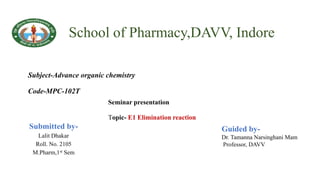
E1 Elimination reaction
- 1. School of Pharmacy,DAVV, Indore Submitted by- Lalit Dhakar Roll. No. 2105 M.Pharm,1st Sem Guided by- Dr. Tamanna Narsinghani Mam Professor, DAVV Subject-Advance organic chemistry Code-MPC-102T Seminar presentation Topic- E1 Elimination reaction
- 2. Index Introduction E1 elimination reaction Mechanism Orientation of E1 reaction Stereochemistry Energy level curve Factor affecting E1 reaction
- 3. Introduction :- • An elimination reaction is a type of chemical reaction where several atoms either in pairs or groups are removed from a molecule. The removal usually takes place due to the action of acids and bases or action of metals. It can also happen through the process of heating at high temperatures.
- 4. There are two mechanisms of elimination (E2 and E1). • E2 mechanism — bimolecular elimination • E1 mechanism — unimolecular elimination
- 5. E1 ELIMINATION REACTION :- • E1 mechanism which is also known as unimolecular elimination, • There is a formation of carbocation as an intermediate. • This happens in the presence of a base which further leads to the formation of a pi-bond in the molecule. • In E1, the reaction rate is also proportional to the concentration of the substance to be transformed. • It exhibits first-order kinetics
- 6. Mechanism:- Step 1- Step 2- • Step 2- A proton is abstracted by the base from the adjacent ß- carbon atom to give the alkene • Reaction mechanism of E1 reaction is two step process • Step 1-Alkyl halide ionized to give the carbonium ion
- 7. Orientation of elimination. :- • Zaitsev's Rule:- • When an elimination reaction gives predominantly the most stable alkene, we say that the reaction follows Zaitsev's rule. • This rule, named after the Russian chemist A. N. Zaitsev (1841-1910), • States that the most highly substituted alkene is the major product in an elimination reaction where more than one alkene can form. • Zaitsev also spelled Saytzeff, Saytsef, or Saytzev
- 8. • Hofmann rule:- • According to this rule major product is always least substituted alkene. • Major product is obtained from formed from ß-carbon which has maximum number of hydrogens. • Product is known as Hofmann product.
- 9. Stereochemistry :- • With C+ both syn and anti elimination can occur, • So E1 reaction forms both E and Z products • ß-carbon is bonded to one or two H’s • Product stability leads to stereoselectivity but not stereospecificity
- 10. Energy level curve :- • Transition state(T.S)- an imaginary molecule and can not be isolated • Intermediate-stable entity an d can be isolated • A reaction is through an intermediate has to surmount two energy barrier • One for the conversion of the reactant to intermediate(Eact1) • Other for the conversion of intermediate into product(Eact2).
- 11. Factor affecting E1 reaction:- A).Effect of alkyl group- Reactivity order: (CH3)3C- > (CH3)2CH- > CH3CH2- > CH3 Increasing rate of E1 reaction Increasing stability of carbocations
- 12. • B).Leaving group:- • The rate determining step of the E1 is breaking the C-LG bond. • Therefore, there is a very strong dependence on the nature of the leaving group, • The better the leaving group, the faster the E1 reaction will be. • Weak base= good leaving group • .Order of leaving group • Fˉ<Clˉ<Brˉ<Iˉ • C).base:- • The base is not involved in the rate determining step, • The nature of the base is unimportant in an E1 reaction.
- 13. • D).Type of solvent:- • Have dipoles due to polar bonds o can H atoms that can be donated into a H-bond. • Anions will be solvated due to H-bonding, • Polar protic solvents will stabilize a carbocation better, therefore promote an E1 reaction. • Water, methanol, • Ethanol, • Isopropyl alcohol, • Acetic acid.
- 14. Application :- • Conversion of mono enes into dienes and trienes. • Conversion of vitamin A1 to vitamin A2
- 15. Reference :- • Morrison and Boyd's advance organic chemistry sixth edition • March’s advance organic chemistry, sixth edition.